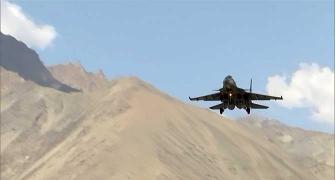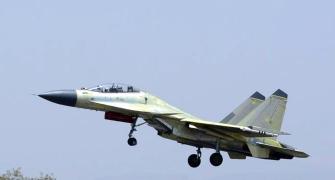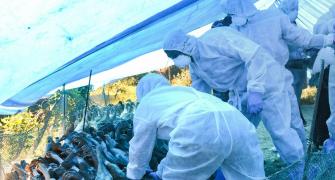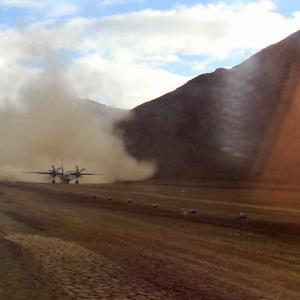The Rafales could begin combat operations by September-October, reports Ajai Shukla.

In a boost to the morale of the Indian Air Force, which finds itself preparing for the possibility of hostilities with China, its first five Rafale fighter aircraft will land on Indian soil on July 27.
The aircraft will form the nucleus of the IAF's first Rafale squadron, Number 17 Squadron, which calls itself the Golden Arrows. They will be based in Ambala.
The five Rafales will take off from Istres, France, and will be flown to India by IAF pilots, with mid-air refuelling en route from an accompanying French airforce tanker aircraft.
They will make just one stopover -- at the United Arab Emirates's Al Dhafra air base near Abu Dhabi, according to Livefist, an authoritative defence blog.
The IAF stated on Monday that the arrival of the first Rafales will be low-key and without ceremony or media coverage. A more public inauguration will take place at the end of August.
In September 2016, the IAF had signed a €7.8-billion contract with the French aerospace firm Dassault for 36 Rafale fighter aircraft, which were to commence delivery in September 2019.
As it turns out, the delivery is commencing nine months late. With the first squadron likely to take about three months to become operationally ready, the Rafales could begin combat operations by September-October.
'IAF air crew and ground crew have undergone comprehensive training on the aircraft, including its highly advanced weapons systems and are fully operational now. After arrival, efforts will focus on operationalisation of the aircraft at the earliest,' the IAF stated.
With the IAF pressing Dassault to deliver fighters quickly to make up for lost time, there are expectations that one-two more Rafales would join the fleet every month.
At that rate, both Rafale squadrons could be delivered and operational by late 2022.
Those could potentially be followed by more Rafales.
In November, the Supreme Court dismissed a bunch of petitions against the Rafale contract, clearing the decks for Dassault to compete with other global vendors in another ongoing Indian procurement for 114 medium fighters.
The weapons that give the Rafale its combat edge over any other in-service fighter in the region have already been delivered to India, ahead of the fighters.
The most potent of these weapons in air-to-air combat (fighter-versus-fighter) is the Meteor beyond visual range, air-to-air missile.
With a range that is estimated to be well above 120 kilometres, the Meteor outranges any other missile in aerial combat and allows a Rafale pilot to strike enemy aircraft from beyond the range of the enemy's missiles.
According to MBDA, the French firm that has developed the Meteor, it is powered by a rocket-ramjet motor that gives it greater engine power and a significantly longer range than any other BVR missile.
The ability to fly faster, for longer distances, and manoeuvre more sharply than other air-to-air missiles give the Meteor a 'no-escape zone' (the arc in which the target aircraft cannot evade the missile) many times greater than its competitors.
The IAF's Rafales will also carry the shorter-range MICA air-to-air missile, which is separately being fitted on to the IAF's Mirage 2000 fighter aircraft fleet as part of its ongoing upgrade.
MBDA claims the MICA is the world's only air-to-air missile that features two interoperable seekers (active radar and imaging infrared), allowing the missile to be used in close-in, fighter-to-fighter dogfights as well as in the BVR role.
One of the MICA's key attributes is its ability, while in the BVR mode, to fly much of the distance to the enemy aircraft in passive mode -- without radiating radar waves, which alert the adversary.
When it approaches the target, the seeker starts radiating only in the final stages when the target has little time to take evasive manoeuvres or to deploy effective countermeasures.
For striking ground targets, the IAF Rafales will carry the French SCALP deep-strike cruise missile.
This stealth weapon has the ability to strike hardened and protected targets deep inside hostile territory from stand-off ranges -- without the need for the Rafale to enter hostile airspace, which could be heavily defended with air defence missiles.
The SCALP has the capability to create havoc at the target end due to its powerful tandem warhead and multiple detonation modes.











